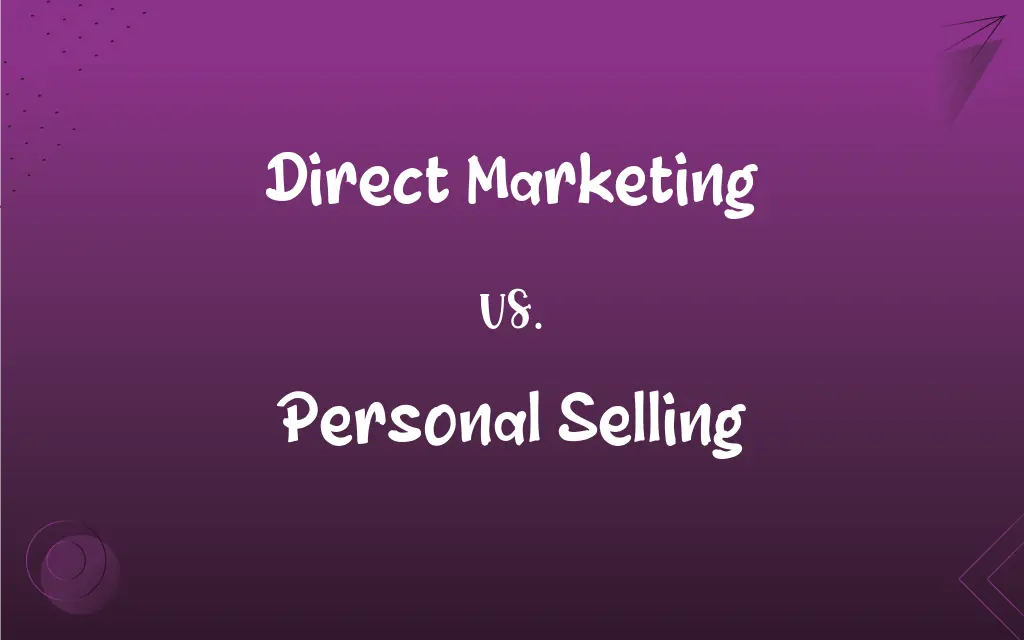Direct Marketing vs. Personal Selling: What's the Difference?
Edited by Aimie Carlson || By Janet White || Published on October 13, 2023
Direct Marketing involves reaching customers directly through various channels like email. Personal Selling entails a direct interaction between the seller and the buyer, often face-to-face.

Key Differences
Direct Marketing operates primarily through various channels, such as emails, text messages, and postal mail, aimed at communicating a promotional message to a targeted group of consumers. On the other hand, Personal Selling usually involves a one-on-one interaction between a sales representative and a potential buyer, with the primary objective of making a sale through the provision of detailed product information and personalized communication.
Direct Marketing often uses comprehensive data and research to identify a target audience, ensuring that the marketing efforts are received by those most likely to respond favorably to the product or service being offered. In contrast, Personal Selling might necessitate an in-depth understanding of the product or service being sold, along with substantial communication skills, as the sales representative seeks to build a relationship with the client through direct interaction.
The effectiveness of Direct Marketing can often be quantitatively assessed through metrics like response rates and conversion rates, providing a tangible measure of the strategy’s ROI (Return on Investment). In the sphere of Personal Selling, while closing a sale is a measurable outcome, the quality of the relationship formed and the potential for future interactions or referrals also play a critical role, though they may not be as easily quantified.
Direct Marketing is frequently employed in B2C (Business to Consumer) contexts, where products and services are promoted directly to the end consumer, utilizing methods like email campaigns, online advertisements, or postal mailings. Conversely, Personal Selling is common in both B2C and B2B (Business to Business) scenarios, where the complexity and cost of the product or service might necessitate a more personalized and detail-oriented selling approach.
The strategy for Direct Marketing generally leans towards mass communication, seeking to reach as many potential customers as possible with a consistent and compelling message. In comparison, Personal Selling adopts a more tailored approach, where the message and selling strategy may be customized to the individual buyer, based on their specific needs, pain points, and buying behavior.
ADVERTISEMENT
Comparison Chart
Interaction Type
Typically one-way communication
Involves two-way communication
Communication Method
Uses various channels like email
Generally involves face-to-face interaction
Personalization Level
Often less personalized
Highly personalized
Scalability
Easily scalable to a large audience
Not as easily scalable
Relationship Building
Not focused on relationship building
Often focuses on relationship building
ADVERTISEMENT
Direct Marketing and Personal Selling Definitions
Direct Marketing
Direct Marketing often employs data analytics to target consumers more likely to purchase the product or service.
By utilizing data analytics in Direct Marketing, the team could identify and target potential clients efficiently.
Personal Selling
Personal Selling allows salespersons to address objections, queries, or concerns directly.
Personal Selling enabled Lisa to immediately address any concerns her clients had, fostering trust.
Direct Marketing
Direct Marketing aims to drive a specific call to action, such as making a purchase or signing up for more information.
The Direct Marketing campaign successfully increased sign-ups for the workshop.
Personal Selling
Personal Selling is commonly utilized in scenarios where products or services are complex or high-value.
Due to the complexity and cost of industrial machinery, Personal Selling is a prevalent sales strategy in the industry.
Direct Marketing
Direct Marketing can be evaluated using metrics like conversion rate and return on investment (ROI).
The effectiveness of the Direct Marketing strategy was analyzed by examining the conversion rates of the email campaign.
Personal Selling
Personal Selling often involves detailed demonstrations or explanations of the product or service.
The software company used Personal Selling to thoroughly demonstrate their product’s unique features to potential clients.
Direct Marketing
Direct Marketing refers to communicating promotional messages directly to a targeted group of consumers.
The company’s Direct Marketing strategy involved sending promotional emails to selected customers.
Personal Selling
Personal Selling typically requires the salesperson to build a relationship with the client to facilitate a sale.
Through Personal Selling, John developed a rapport with clients, enhancing the likelihood of repeat business.
Direct Marketing
Direct Marketing uses channels like email, postal mail, and text messages to reach potential clients without using intermediaries.
Through Direct Marketing, businesses can send special offers directly to their customers’ inboxes.
Personal Selling
Personal Selling involves direct interactions between a sales representative and a potential buyer.
The car salesman employed Personal Selling techniques to understand the buyer’s needs and preferences.
FAQs
What is Direct Marketing?
Direct Marketing involves communicating a promotional message directly to a targeted group of consumers through various channels like email or postal mail.
How does Personal Selling work?
Personal Selling involves one-on-one interactions between a sales representative and a potential buyer, often facilitating in-depth discussions, product demonstrations, and personalized communication.
What are some channels used in Direct Marketing?
Direct Marketing channels can include email, postal mail, telemarketing, and social media ads, among others.
Why is Personal Selling important?
Personal Selling allows for personalized communication, effective handling of queries or objections, and relationship-building, which can be critical in selling complex or high-value products.
What skills are necessary for Personal Selling?
Skills vital for Personal Selling include communication, empathy, product knowledge, objection handling, and relationship-building.
How is the success of Direct Marketing measured?
Success in Direct Marketing is typically measured using metrics like conversion rates, response rates, and return on investment (ROI).
What is the role of a sales representative in Personal Selling?
In Personal Selling, a sales representative engages directly with potential buyers, offering detailed product information, handling objections, and often aiming to form a lasting client relationship.
When is Direct Marketing typically used?
Direct Marketing is often utilized to reach a large audience with specific promotional messages, such as offers, discounts, or new product launches.
What are the advantages of Direct Marketing?
Advantages of Direct Marketing include targeted communication, measurability of campaigns, and often, cost-effectiveness in reaching large audiences.
Is Personal Selling suitable for all types of products?
Personal Selling is often more suitable for products or services that are complex, high-value, or require detailed explanations and demonstrations.
About Author
Written by
Janet WhiteJanet White has been an esteemed writer and blogger for Difference Wiki. Holding a Master's degree in Science and Medical Journalism from the prestigious Boston University, she has consistently demonstrated her expertise and passion for her field. When she's not immersed in her work, Janet relishes her time exercising, delving into a good book, and cherishing moments with friends and family.
Edited by
Aimie CarlsonAimie Carlson, holding a master's degree in English literature, is a fervent English language enthusiast. She lends her writing talents to Difference Wiki, a prominent website that specializes in comparisons, offering readers insightful analyses that both captivate and inform.






































































